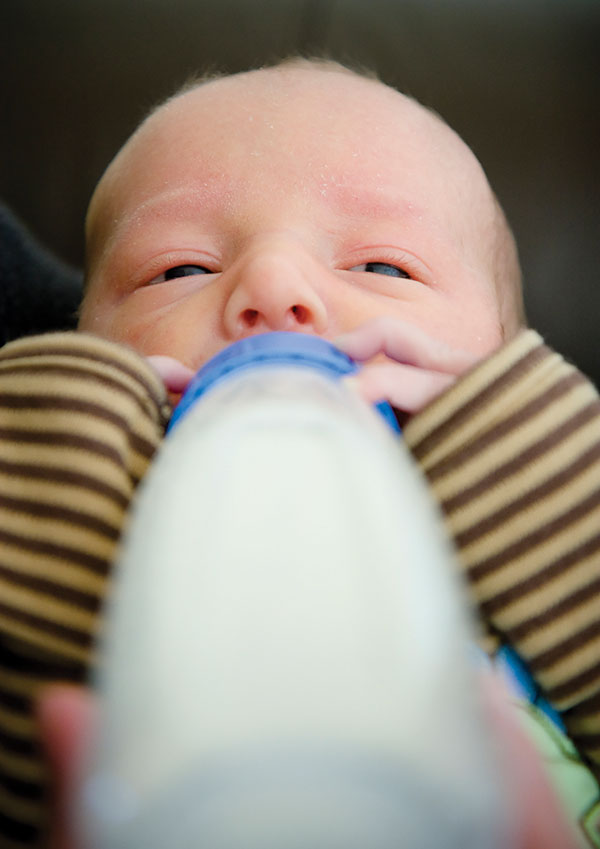 When Kendall Chase of Shoreline, Wash., gave birth last June, she planned to breast-feed. But two weeks in, her son Parker was losing weight, and her milk supply appeared to be faltering. When her pediatrician suggested she supplement with donor milk — breast milk from another lactating mother — as an alternative to formula, Chase and her husband, Craig, were receptive.
When Kendall Chase of Shoreline, Wash., gave birth last June, she planned to breast-feed. But two weeks in, her son Parker was losing weight, and her milk supply appeared to be faltering. When her pediatrician suggested she supplement with donor milk — breast milk from another lactating mother — as an alternative to formula, Chase and her husband, Craig, were receptive.
With support from Parker’s doctor, they found a healthy local donor and picked up the first milk donation that very night. Within two days, they were in contact with a long-term donor.
Chase did what she thought was best for Parker, and she took precautions, selecting healthy donors whom her pediatrician knew and trusted. But according to the American Academy of Pediatrics (AAP), this type of informal milk-sharing — milk shared mom to mom, instead of through a milk bank — puts babies at risk.
Both the AAP and the Food and Drug Administration (FDA) discourage mom-to-mom milk-sharing, and a recent study published in Pediatrics found high levels of staphylococcus bacteria and a few instances of salmonella in samples of breast milk sold online. At press time, New Jersey state legislators were due to vote on A3702, the first bill aimed at creating a campaign to “warn parents about the dangers of casual milk-sharing.”
The business of breast milk
Human milk is widely acknowledged as the safest, best food source and immune booster for infants, offering protection against a host of diseases and conditions, from bacterial infections and respiratory illness to diabetes and obesity. When a mom can’t produce enough milk on her own, the AAP recommends pasteurized donor milk (generally, milk obtained from a milk bank that has been treated with heat to kill any pathogens).
While some parents in this situation opt for formula, which can provide needed calories, others want their children to receive breast milk because of a family history of sensitivity to dairy or soy proteins, wariness about formula ingredients or a firm belief in the power of nature’s “perfect food.” But many parents can’t get the pasteurized donor milk available at reputable nonprofit milk banks, such as Northwest Mothers Milk Bank in Portland, Ore., because it’s reserved mainly for premature or vulnerable infants and available only by prescription. Plus, banked milk is spendy: The average $3–$4 per ounce puts this “liquid gold” out of reach for many families (an infant can drink 30–40 ounces of milk each day).
The highly restricted market for banked milk forces parents to look elsewhere, and the world of e-commerce is eager to fill demand. A number of websites enable parents to browse classified ads and purchase breast milk for as little as $1 per ounce.
This type of anonymous transaction — buyers and sellers don’t know each other, and milk is often shipped long-distance — is the kind of sharing criticized by Pediatrics. With good reason, says breast-feeding expert Isabella Knox, M.D., Ed.M., associate professor of pediatrics at University of Washington Medical Center. It poses risks to the baby receiving the donated milk.
These risks go beyond the bacterial contamination referenced in Pediatrics. Those results weren’t surprising, Knox says, because the type of milk studied — unrefrigerated, unpasteurized milk shipped long-distance — starts to break down quickly.
“Rotted human milk is dangerous in the short run, with the chance of introducing a serious infection, not to mention the deteriorated nutrients, such as rancid fat,” she says. (Unpasteurized breast milk can remain fresh in the refrigerator for 96 hours and at room temperature for as long as six hours.)
Certain viral infections, such as hepatitis B, HIV and cytomegalovirus, are also passed into breast milk, Knox says.
Then there’s the question of the milk’s true source. “When milk is purchased, who says it’s breast milk?” says leading breast-feeding researcher Jack Newman, M.D., a Toronto pediatrician and the author of The Ultimate Breastfeeding Book of Answers.
Risks and rewards
Despite these risks, donated milk is still superior to infant formula, Knox says, which makes safer milk-sharing a worthy goal.
Human milk contains minimal proteins from other species (for example, cow-milk protein) that could potentially cause allergies in an infant, she says, and many substances in human milk are uniquely suited to protect infants from infections.
When stored and transported properly, donated breast milk isn’t that different from a mother’s own milk, Newman says. “It may lose some of the antibodies and probably all of the white cells [in storage], but it’s essentially the same as the milk a mother expresses and stores for her own baby.” And, he notes, formula contains no infection-fighting white cells at all.
According to the Human Milk Banking Association of North America, there has never been a documented case of death or even disease transmission resulting from donated milk.
How to share safely
Safer milk-sharing is possible, Newman says, as long as parents follow a few guidelines.
First and foremost, he says, parents should never buy milk from an individual (not-for-profit milk banks are his exception to this rule): “As soon as commerce enters the equation, you can’t be sure what you’re getting.”
 If pasteurized banked milk is unavailable, friend-to-friend sharing is safer than milk purchased from strangers online, Newman says, adding that formula is preferable to breast milk purchased long-distance from strangers.
If pasteurized banked milk is unavailable, friend-to-friend sharing is safer than milk purchased from strangers online, Newman says, adding that formula is preferable to breast milk purchased long-distance from strangers.
“Parents should meet the donor and get information about her and her baby,” he says. “If the donor is healthy and her baby is healthy, it’s likely her milk is safe.”
Online communities Eats on Feets and Human Milk 4 Human Babies connect parents in need of milk to moms with milk to spare, nearly always local. Megan Lantz of Redmond, Wash., mom to a toddler, has donated thousands of ounces to moms she met through these groups.
“Free” is a key aspect of safer milk-sharing, according to Newman, Lantz and others. “When you take money out of the transaction, it boils down to pure goodness,” Lantz says. Moms who share this way are motivated to take care of themselves and their milk, because they’re in it for the right reason: To see another baby flourish.
There’s a world of difference between anonymous Internet selling and face-to-face sharing, says milk donor Allyson Madere, a Shoreline, Wash., mom of two young daughters.
“Establishing a relationship with someone and donating your milk directly to them is very different than buying it anonymously and receiving [it] days later, defrosted and full of bacteria,” Madere says.
Clean, clear and under control
Other safety precautions for milk recipients include ensuring that donors sterilize pump equipment after each pumping session, and making sure that milk is transported and stored safely.
Some parents using donated breast milk screen their donors for medications. Colleen Young of Tacoma, Wash., uses milk from five different donors for 8-month-old Nico, and she discontinued one donor relationship because the mom used antidepressants, which can pass into breast milk.
“It would be useful if the donor has had a blood test for HIV and other viruses, such as hepatitis B,” Newman says. Knox also encourages screening for viruses, but she acknowledges that blood testing may be costly and inconvenient for some.
Parents who want more assurance about milk safety can pasteurize milk at home, Newman says. The World Health Organization recommends killing potentially harmful pathogens in expressed milk by flash-heating, a low-tech form of home pasteurization in which milk is heated to higher than 160 degrees, although some milk-sharing moms don’t perform this step because they feel it can adversely affect breast-milk quality.
The path to normalization
Colleen Young would like to see milk-sharing become more mainstream. “One of my donors likened milk-sharing to blood-banking: We’d never create synthetic blood, and most people don’t think using donated blood is odd. Breast milk is the same concept. There is no substitute,” she says.
Chase agrees. Donated milk helped her son thrive while she worked on building her own milk supply; now 8 months old, Parker drinks just a few ounces of donated milk per day. “Our donors will always have a very special place in our lives,” Chase says. “They helped my son grow strong.”











